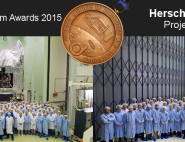Herschel reveals the Milky Way's warm heart
What heats gas near supermassive black holes at the centre of galaxies?
Astronomers have looked at the centre of our Galaxy, the Milky Way, with ESA's Herschel Space Observatory and discovered a rich variety of molecules at surprisingly high temperatures - up to 1000 K. The new data suggest that the molecular gas is heated up by shocks, in addition to ultraviolet radiation from massive stars close to the Galactic Centre. Shocks develop in the gas as the material surges towards Sagittarius A*, the region harbouring the supermassive black hole at the heart of the Milky Way.
![]()
This illustration shows an artist's impression of the environment at the centre of our Galaxy, the Milky Way. The Galactic Centre hosts a supermassive black hole in the region known as Sagittarius A*, or Sgr A*. With the mass of about 4 million times that of our Sun, this black hole currently accretes matter from its surroundings at very moderate rates compared to the vigorous processes that characterise black-hole accretion in galaxies hosting an Active Galactic Nucleus (AGN). Credit: ESA - C. Carreau
New research based on spectroscopic data from Herschel has resolved the innermost portion of the Milky Way - a few light-years around Sgr A* - for the first time at far-infrared wavelengths. The astronomers were able to isolate the far-infrared emission from all the interstellar components that surround Sgr A* - neutral atomic, molecular and ionised gas, as well as dust. In particular, they exploited the characteristic signature from several molecules to trace the temperature, density and other properties of the material that orbits the central black hole and is possibly falling onto it.
![]()
This illustration combines a view, obtained at radio wavelengths, of ionised gas at the centre of our Galaxy, the Milky Way (left panel), with a spectroscopic view of the very central region, taken with ESA's Herschel Space Observatory at far-infrared wavelengths (right panel). In this continuum-subtracted spectrum, the characteristic signatures of many chemical species can be seen.
Credit: Radio-wavelength image: National Radio Astronomy Observatory/Very Large Array (Courtesy of C. Lang); Spectrum: ESA/Herschel/PACS, SPIRE/J. Goicoechea et al. (2013)
A surprisingly rich variety of molecules in the environment of Sgr A*, that really exceeded expectations, were detected. The molecules range from highly excited carbon monoxide and water vapour, to hydrogen cyanide and many light molecules that play a critical role in the chemistry of the interstellar medium. Some of them had not been detected before Herschel.
Read the complete news on ESA's website
Publication:
"Herschel Far-Infrared Spectroscopy of the Galactic Center. Hot Molecular Gas: Shocks versus Radiation near Sgr A*", J. R. Goicoechea, et al., 2013, Astrophysical Journal Letters, in press.


